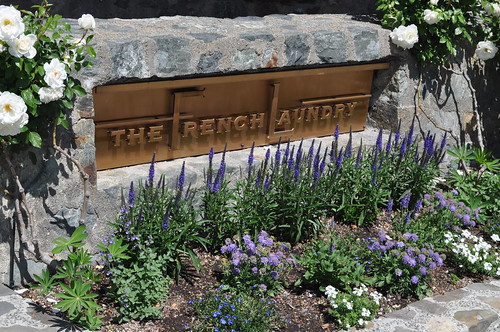
THE FRENCH LAUNDRY: HOW IT ALL BEGAN
Stefie: Over the last ten years, I have dreamed, fantasized, and waxed poetic about the day that I would step foot into the space that once housed a French steam laundry in the 1920s, which has since then been transformed by the renowned American chef, Thomas Keller, into an award-winning restaurant that has landed many a precious spot on every foodie's "bucket list" of restaurants. I clearly remember the first time I had heard about The French Laundry. My aunt Cynthia and uncle Frank had just come back from the Bay Area, after being invited to dine at The French Laundry with a large group of family friends in the private dining room, where each diner had his/her own course runner, guaranteeing that each plate was served just seconds right out of the kitchen. I was amazed by how much attention this one restaurant in the Napa Valley could so easily accommodate its patrons with that much attention and detail. That's when my fascination began -- Auntie Cynthia had shown me the souvenir clothespin that held each diner's napkin, and it stuck. I had become enamored with this little trinket and everything I found it to represent -- that the epitome of fine dining starts with simplicity (along with some playfulness and intellect). It wasn’t until recently that I had learned how much Chef Keller took this to heart.
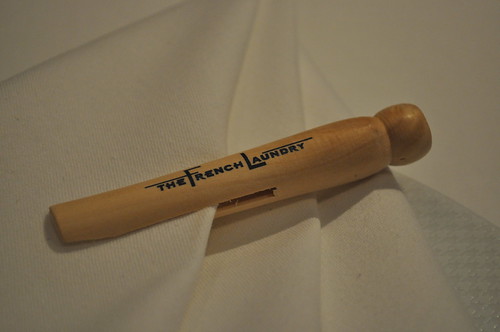
But as a teenager, I knew dining at The French Laundry (aptly named) wouldn't materialize until I was much older, and the only way I could "experience" anything close to the possibility of sitting and enjoying a meal in Chef Keller's highly-demanded dining room would be through the beautiful photographs taken by Deborah Jones in multiple award-winning The French Laundry Cookbook. The food porn, if you will, would be enough to satisfy any manic foodie, if only temporarily as an easy fix.
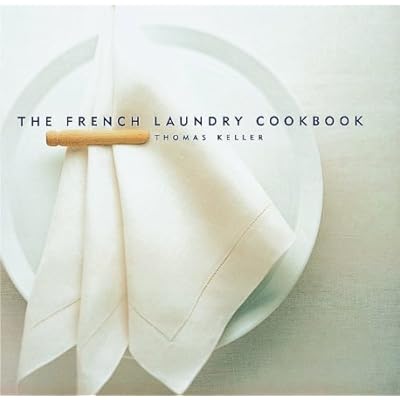
So before I could get my hands on a copy of the cookbook, I ran into another problem--$50 was a pretty steep price at the time to shell out for a cookbook, even a book at all. My allowance didn't permit such a purchase at the time, so I would peruse the white-sleeved book (you know, the kind made to sit on display on modern coffee tables) whenever I saw it at a bookstore. However, a few years ago, my uncle, Alan, had a surprise for me. It was a copy of The French Laundry Cookbook that he snagged as a gift for me from a used bookstore, and I absolutely fell in love with it. I loved the worn and slightly tattered pages -- it gave the book some character and evidence of actual use, instead of just sitting there looking pretty. It made my copy of the cookbook that much more special. It'd be the book I turned to if I need a little cheering up -- a few minutes poring over the cookbook's pages, and I'd feel loads better.
For those of you out there who aren't familiar (and those who are) with Chef Keller and The French Laundry, I just wanted to briefly share some interesting background that you may (not) have known prior to reading this post. Chef Keller began his career at a relatively early age, working at the Palm Beach Yacht Club in Florida during his teenage summers, starting as a dishwasher and quickly moving up to cook. Later summers, he worked as a cook in Rhode Island at The Dunes Club, under French-born chef, Roland Henin, from whom he learned the fundamentals of French cooking. After his time with Chef Henin at The Dunes Club, he became a cook at a small French restaurant called La Rive in the Hudson River Valley of Upstate New York. At La Rive, he was given free reign, and with this freedom, he built a smokehouse to cure meats, developed relationships with local purveyors, and learned to cook entrails and offal under his old mentor, Chef Henin, who would drop by on occasional weekends.
With three years at La Rive under his belt, still unable to buy it from the owners, he left and moved to Paris in 1983, apprenticing at a couple Michelin-starred restaurants such as Guy Savoy and Taillevent. He returned back to New York City in 1984, where he was hired as chef de cuisine at La Reserve, where he left after a year to open his first restaurant, Rakel. Rakel catered to the expensive tastes of Wall Street executives with its refined French cuisine, which eventually won a two-star review from The New York Times. Unfortunately, its popularity dwindled in light of the stagnant economy, resulting in Chef Keller's departure, as he wanted to continue his focus on fine dining and was unwilling to compromise his style of cooking to simple bistro fare.
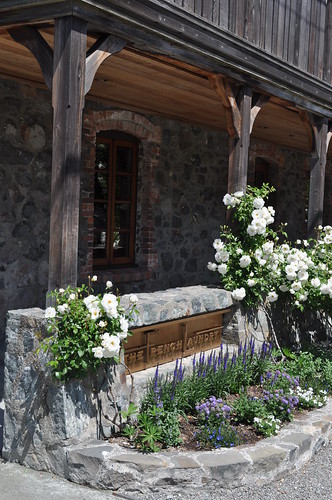
After leaving New York, Chef Keller headed to California to a position as executive chef at Checkers Hotel in Los Angeles. During the spring of 1992, he stumbled upon a restaurant that used to be an old French steam laundry in Yountville (in the Napa Valley) which had since been converted into a restaurant after Don Schmitt, mayor of Yountville, and his wife had purchased it back in 1974. As everyone in town knew the property as "The French Laundry," the name stuck and thus became the name of the restaurant. From there, Chef Keller began raising money to purchase the building from the Schmitts, and in about nineteen months, he successfully raises $1.2 million from acquaintances and investors, opening the restaurant in 1994. The French Laundry, now headed and owned by Chef Keller, aimed to serve American food with French influences. Following a disastrous opening night, the restaurant persevered for much improvement, striving for excellence and perfection. That same year, The French Laundry is named one of the "Ten Best New Restaurants" by Esquire magazine's John Mariani and is nominated for "Best New Restaurant" by Michael Bauer of the San Francisco Chronicle (consequently awarding it four stars). Herb Caen of the San Francisco Chronicle also awarded it five stars shortly after, too.
The next year, the restaurant adopts at nine-course tasting menu in an effort to "'create a more gracious, composed atmosphere." The French Laundry also began to attract talented chefs such as Jonathan Benno, Jeffrey Cerciello, Eric Ziebold, Grant Achatz, Gregory Short, and Ron Siegel--all who helped The French Laundry become "the most exciting restaurant in America," as written by Ruth Reichl in The New York Times in 1997.
Since then, Chef Keller and his flagship restaurant quickly garnered national acclaim. He was named "America's Best Chef" in 2001 by Time magazine and has won consecutive "Best Chef" awards from the James Beard Foundation. He now owns and operates Bouchon (his French bistro in Yountville and Las Vegas), Bouchon Bakery (with locations in Yountville, Las Vegas, and New York City), Per Se (the East Coast sister of The French Laundry), and Ad Hoc (his family-style restaurant). The French Laundry has been a consistent perennial awardee on Restaurant magazine's list of the S. Pellegrino World's 50 Best Restaurants. What is more is that he is the only American-born chef to hold multiple three-star ratings by the Michelin Guide, having received a total of seven stars in the 2011 edition.
AN EXERCISE IN FUTILITY: ACQUIRING A RESERVATION
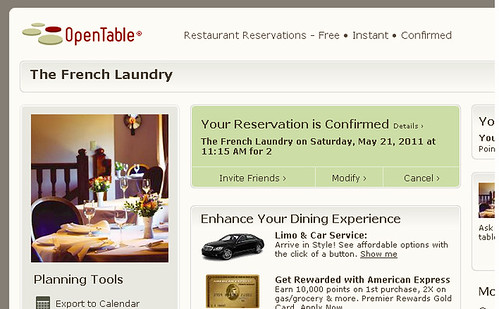
Stefie: After two days of calling The French Laundry non-stop when its phone lines opened for reservations in mid-May and not getting through until all tables have been taken (resorting us to its just-as-impossible waitlist), we hit some stroke of amazing luck. Marcus miraculously scored us a lunch reservation via OpenTable for Saturday, May 21, 2011! For further details, please see Marcus's guest post on "Getting Reservations at The French Laundry," where he goes in depth about how we got our reservation and what you need to know about the process, the restaurant's policy, and all of that good stuff.
PRELUDE TO YOUNTVILLE: EARLY THOUGHTS
Stefie: The French Laundry was (and is) the first restaurant to appear on my "bucket list" -- even before I knew what one was or kept one myself. It has always been that restaurant that I hold very close to my heart, mainly because it was the restaurant that first got me interested in haute cuisine, gastronomy, and the culinary world. I knew the day I'd finally make my visit would be a very special one, not only because it would be The French Laundry, but also because I know the company I'll have during that meal will be even more meaningful to the whole experience (a preliminary thank you to Marcus for spending that special day with me!).
With that being said, it was really important for me to walk into our lunch at The French Laundry with barely any expectations, as any ounce of expectation or any ideas of grandeur could totally ruin the whole experience with some serious disappointment. During our two months of waiting until arriving in Yountville, I desperately tried not to get overhyped, but to instead remain calm and relaxed about the idea of finally dining at The French Laundry. I thoroughly kept from reading any articles, reviews, or blog posts about its cuisine, menu, and dining experience -- kind of like avoiding "spoilers" for a new film or television episode. But let's face it -- in the depths of my mind, no matter how much I knew I had convinced myself to lack any expectations, there were some, hidden and tucked away, intuitively knowing to expect and taste nothing less than perfection on pristine, porcelain china over a white, wrinkle-free table cloth inside Chef Keller's sanctuary of fine cuisine.
Marcus: In your typical review of The French Laundry, the author loads up the verbal cannons full of superlatives and unleashes a flurry of compliments that have been augmented by hyperbole, fortified with euphoria, and unabashedly wrapped in bacon. After all, The French Laundry is widely acclaimed as being one of the best restaurants in the world, where securing a reservation is truly an oxymoronic notion. To even offer a constructive criticism -- to throw stones at the nexus of culinary genius and unyielding discipline -- makes me consider sleeping with one eye open. Who am I to judge Chef Thomas Keller? I'm a gastronomic layman who sometimes confuses tofu for chicken, excitedly orders hot cocoa like a toddler, and fails to pronounce just about anything correctly from a French dinner menu (the general rule of thumb: All letters are silent). Chef Keller's attempts to dazzle me with ambrosia could arguably reduce to mere pearls before swine when taking my unsophisticated tongue and cursory knowledge into account.
However, perhaps I am being hard on myself. Chef Ferran Adrià of elBulli suggested that talented, sensitive palates are extraordinarily rare. In most cases, it's not so much a matter of being born with a superior slab of taste buds as it is acquiring an "enlightened capacity" for comprehending stimuli, where that capacity derives from an extensive knowledge of food, awareness of culture, and lots of experience. In step with that notion, critics like Robin Goldstein argue that, for instance, a vast majority of people can't tell the difference between cheap wine and expensive wine in a blind taste test. A $10 bottle of wine from a Washington vineyard can muscle its way above a $150 bottle of Dom Pérignon if the labels are switched (or omitted entirely), but if the labels are left intact, the Dom Pérignon emerges victorious. In other words, our opinions on quality shift when we know something about the price ahead of time, and when we don't know the price, all we have is our sensation of taste that is already quite loose-weave and unreliable to begin with.
It seems obvious that perception is an extremely volatile thing that fuels itself from the nature of context and not so much on anything universal or objective. Nevertheless, the hype is everywhere. Practically every review of The French Laundry you'll ever come across -- every comment, every post -- holds the restaurant in the highest regard. I suspected that a large part of this phenomenon was attributable to cognitive dissonance. Nobody wants to feel as if their large meal-investment was made in vain. On top of that, it would require inordinately bold cojones for someone to get a reservation at a world-renowned restaurant, journey out to a remote, farflung location, drop a grand for a meal, and then proclaim "Eh, it was alright" or outright admit they were let down -- especially when there are other people who would have loved to be there instead and simply weren't as fortunate either in terms of finding the time, being able to afford the discomforting hefty bill, or landing a reservation. It's far, far easier to convince oneself that the whole experience was nothing short of amazing. Anything uttered to the contrary comes off as crass, disrespectful, and ungrateful. There was no doubt in my mind that the food would be terrific, but I questioned whether or not it would be as transcendent as legend had it, let alone worth the cost.
Was there some merit to these concerns? Could it be possible that the restaurant was good, but just overrated and overpriced? Or would The French Laundry really be one of the best meals I'd ever have, if not the best? The only way Stefie and I could really know the answers to any of these questions for sure would be to experience it for ourselves.
THE ARRIVAL: FIRST IMPRESSIONS, ATMOSPHERE, AND AMBIANCE

Marcus: When Stefie and I arrived in Yountville and pulled up to the restaurant, we were a bit surprised. Wrought forth from stone and timber, the building is very unpretentious and can be easy to miss. We drove over the crackle and pop of the gravel pathway before parking alongside a nearby street before finally getting out of the car to get a feel for the surroundings. There was a somewhat gentle charm to the place, which resembled a classic French restaurant out in the countryside, but at the same time, it was accentuated by an almost eerie (but calm) stillness. The restaurant reminded me of a monastery, of sorts.
Stefie: The simplicity of the quaint elegance really tugged at my heartstrings. There was, of course, the plentiful but delicate petunias that gently spilled over the wood and stone exterior, resonating an understated beauty. The French Laundry isn't at all ostentatious -- something I really admire in fine dining. Nothing needs to be a spectacle. The simple elegance here sets the stage for a relaxed meal that awaits you once you step through the entrance doors. The atmosphere is serene with no distractions to the nine courses meticulously crafted for your enjoyment and excitement over the next several hours.
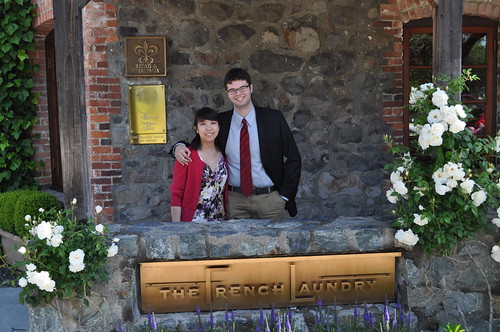
Stefie: Marcus and I standing outside at The French Laundry.

Stefie: The French Laundry is proudly part of Relais & Châteaux, an exclusive collection of 475 of the finest hotels and gourmet restaurants in fifty-five countries. Established in France in 1954, the organization's mission is "to spread its unique art de vivre (French for "way of life") across the globe by selecting outstanding properties with a truly unique character." More specifically, its main ambition is: "All around the world, unique in the world." The restaurant is also a part of Traditions & Qualité, a group of Parisian restaurateurs with the aim of promoting gastronomy and a specific art de vivre, compiled in a list entitled "Les Grandes Tables du Monde" (French for "the best/largest tables of the world").

Walking into The French Laundry.

The courtyard right outside the kitchen and entrance of the restaurant.
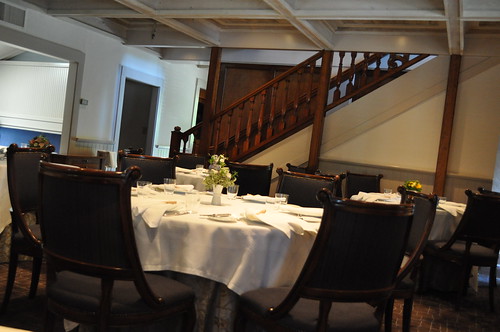
Stefie: We were promptly seated at 11:15 AM in the lower dining room, tucked in an intimate little corner facing the kitchen doorway and the stairs that lead to the second level. The restrooms are located on the second level, so when I made a trip up there, the view was lovely, with the old wooden shutter windows open, looking onto the restaurant's culinary garden across Washington Street.
Marcus: The first thing I noticed after entering the dining room was how spartan/homey it was compared to the outside of the building. Clearly, Chef Keller didn't want your focus to be anywhere other than your table!
THE MEAL OF ALL MEALS: THE CHEF'S TASTING MENU AT THE FRENCH LAUNDRY

Stefie: The French Laundry menu changes daily, and in turn, the date on top of the menu, too. The restaurant creates two different menus each day -- a chef's tasting menu and a tasting of vegetables menu, both of which are available for lunch and dinner service. Each menu is created as "a series of smaller, focused dishes," where "no single ingredient is repeated throughout the meal." The kitchen wants "the peak of sensation on the palate" to be all its patrons feel during each course, where they want to say, "I wish I had one more bite of that," and then it's gone. Chef Keller further states on his website: "We want you to feel special when you're here, we want you to expect that every last detail is taken care of for you so that you feel welcomed, relaxed, and at ease. And most of all happy. Because that's really what it's all about. We don't want to impress you. We want to cook for you and make you happy." A very specific mission and intention here, I must say.
As you'll see throughout the course of our meal, some of the dishes on Chef Keller's menus have whimsical names, which I find to be truly clever, even ingenious -- just the amount of intellect, wit, and context required to execute and understand this, paired with talent and skill in culinary craft is simply astounding. You may wonder if these labels are accurate, and indeed, they are, but The French Laundry explains on its website that the name typically more closely describes the inspiration, not necessarily the ingredients included/used. The idea here, the restaurant implores, is "to take something familiar and find a way to evolve it so that it reminds you that you've come here to have a good time." When asked about these "whimsical" names, Chef Keller simply responded, "It's all about making people comfortable. What's more comforting than the macaroni and cheese that your mom made for you? This is about fun. If you can't have fun making and eating food like this, why do it?"
Additionally, when we ran through the menu with our captain, there were certain courses for which a choice between two dishes was given. In an attempt to gain the most variety from our nine-course lunch, Marcus suggested that we each order something different when possible. This led to us having a chef's tasting of twelve courses, as opposed to just nine. However, with some of these additional choices there came at an additional supplement to the prix fixe cost, which I note under "Price Point" at the end of this post.

Stefie: When we were presented the wine list, it wasn't in the form I had expected it--you know, the restaurant's extensive listing of wine offerings printed on smooth and thick cardstock contained in a leather binder of sorts. It was loaded right into an iPad with a custom leather cover for The French Laundry--the signature clothespin was embossed right on the cover of the case. It even has a feature whereby you tap the wine you wish to order, and you can add it to a menu equivalent to an "online shopping cart" so once you hand it back to your captain, he'll know exactly the respective wine(s) to retrieve for you.

Table settings at The French Laundry.
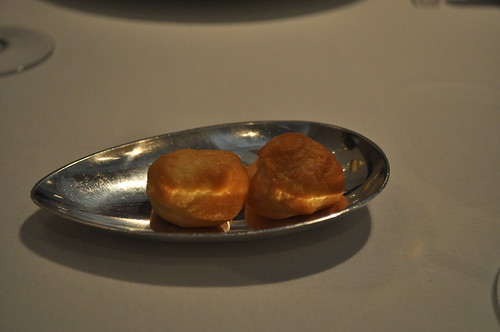
Stefie: In true French Laundry fashion, our first amuse-bouche was the warm gougères filled with Gruyère cheese. They had definitely just pulled these out of the oven because choux pastry was so warm and fresh filled with the creaminess of the Gruyère.
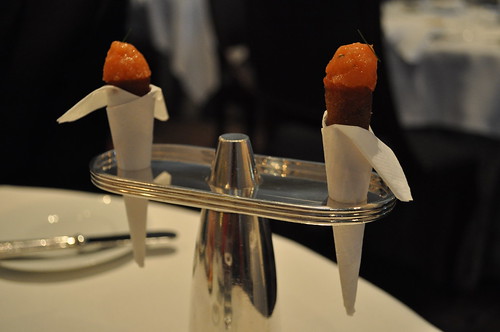
Stefie: The warm gougères were followed by the infamous sesame tuile "cornets" of salmon tartare with red onion and crème fraîche. You have Chef Keller starting to be playful with the menu from the get-go! The cone-shaped cornet resembles that of delicate ice cream cone, but instead of a scoop of your favorite flavor on top, it is a carefully placed dollop of salmon tartare with red onion and crème fraîche on the inside of the cornets -- a clever take on “bagel with cream cheese and lox.” The cornet itself was perfectly wrapped into its shape, toasted to its ideal brownness, resulting in that crunch you remember as a kid when you ordered your summer ice cream scoops in a cone and took that first bite of ice cream with the waffle cone rim. I enjoyed this amuse-bouche very much--and it did indeed leave me wanting just one more bite of it when I realized I had already finished it! I also love way the napkin was wrapped around the cornet as if it needs to also abide by the dress code at The French Laundry--collared shirt and all.
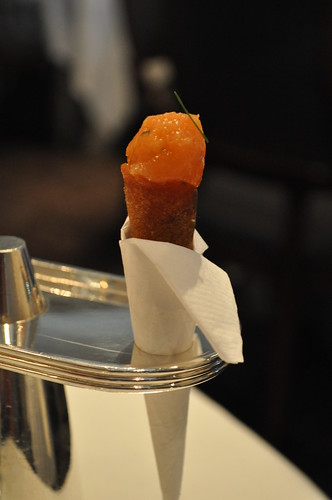
Marcus: Part of me wished that Stefie was allergic to fish because I could have easily gone for another one (or ten) of these. One thing that stood out to me above everything else was how strong the salmon actually tasted. It's a lot like getting slapped in the mouth with a raw fish (I obviously assume everyone can relate to such an experience). I could tell that the salmon was very fresh by the intensity of its taste alone (and this simultaneously made my stomach churn at the thought of how much bland/forgettable salmon I've had in my life -- an indication of how not fresh my fish intake had been over the years). What makes the cornet interesting is that as you take one bite after another, there is more cream to supplement the finish of the salmon, and yet at the same time there is just enough cone to balance the textures. This way you never, at any point, think "Hey, there's too much crème fraîche in this cornet!" in the same way you might chow down on a standard ice cream cone and get put off by the overpowering glut of chocolate nestled at the bottom which only serves to scoff at your misfortune.

Stefie: For the first course, our captain prepared us with the appropriate cutlery which included a spoon made from mother-of-pearl for each of our first courses, both containing caviar. The reason for the use of this pearly spoon is due to its nonreactive nature, letting caviar's fragile flavor reign, imparting no unwanted scents or flavors.

Stefie: I started with The French Laundry classic, "Oysters and Pearls"--a "sabayon" of pearl tapioca with Island Creek oysters and white sturgeon caviar. Here's another example of playfulness illustrated in form of the menu item's name and its resulting execution. The oysters are indeed contained in the dish, but the "pearls" aren't the typical pearls you expect to find when you open their shells. They're in the form of tapioca pearls! While tapioca may not be as glamorous as oyster pearls, Chef Keller throws in some white sturgeon caviar for good measure. I was immediately blown away by this first course--the warm sabayon of pearl tapioca had the most intense of flavor with the caviar, which was sharp but not biting and briny like the caviar I’ve had before. The resulting composition of this flavor along with texture was an artistic one, indeed--a savory masterpiece that sets the tone for the rest of the chef’s tasting. The oysters were cooked to its optimal temperature, where they were tender enough to almost melt away with the sabayon against the warm moisture inside your mouth. It is no wonder that this dish is a French Laundry classic.

Marcus: My starter (a supplemental course) was the Royal Ossetra caviar served with a buckwheat waffle, apple marmalade, oyster lettuce, and black pepper crème fraîche. This dish taught me that you really don't need to be a mustache-flaunting, monocle-toting gentleman to enjoy caviar. There were a lot of interesting textures all at once, ranging from the stickiness of the marmalade clusters to the silky sheen of the flavorful caviar to the cushion of the waffle. The marmalade actually had a much more profound flavor compared to the caviar (which surprised me, considering how strong the salmon was in the cornets we had moments prior) -- a sort of biting sweetness that reminded me more of pineapple than apple, but very appealing.
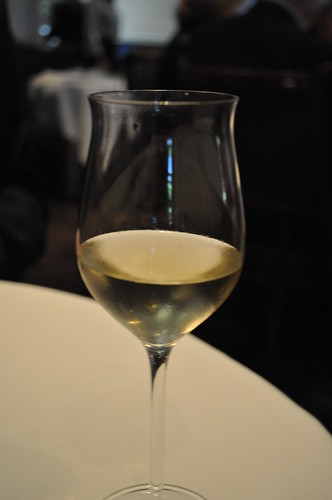
Stefie: We each had a glass of the 2007 "Haardter Herzog" Riesling (Kabinett Reserve) by Weegmüller from Pfalz, Germany. It was a semi-sweet wine (though I'd say more on the sweeter side), which made for a nice start to the meal we had ahead of us. It was a semi-sweet wine (though I'd say more on the sweeter side), which made for a nice start to the meal we had ahead of us. It had a slightly heavier body than most white wines, most likely due to the higher residual sugar content as a Riesling. It had a nectary taste -- a bit sweet like honey, only not as heavy. It went fairly well with the lighter courses during the initial half of the chef's tasting, including the seafood items. Highly recommended! We opted for a glass of red for the heartier, meat courses later on.
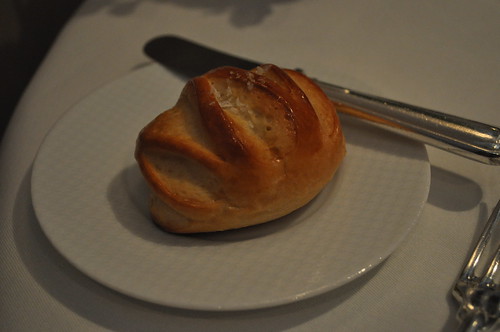
Stefie: Our first bread service during the meal included a pan au lait sprinkled with sea salt on top, sourced directly from Chef Keller's Bouchon Bakery down the road. The pan au lait was lovely--its crusty exterior (almost as light as a croissant) paired with its warm, buttery center was enough to leave you wanting more (The French Laundry's top focus reiterated once again).
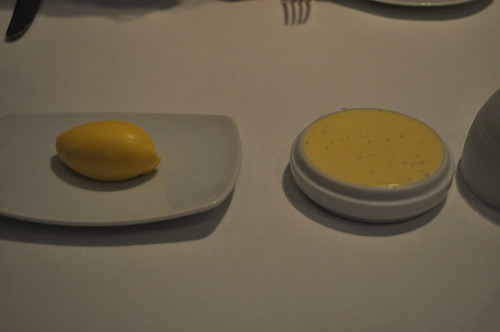
Stefie: To be spread over the freshly made breads brought to our table, we were given two types of butter--an unsalted one from California and a salted one from Vermont. I preferred the latter because I like a little saltiness in my butter.
Marcus: Both butters taste very good, but the salted butter is a little easier to access and spread. My dexterity with silverware is not great, so I played it safe and stuck with the salted butter because I didn't feel like picking metal out of my foot later.
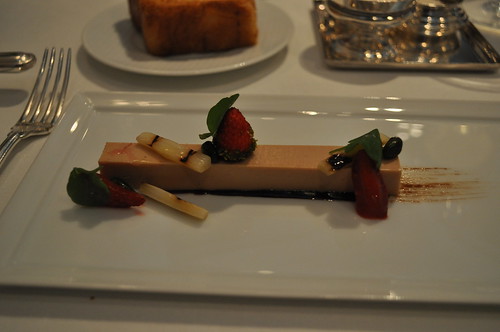
Stefie: As my second course, I chose the Moulard duck "foie gras en terrine" (a supplemental course) with Silverado Trail strawberries, Holland white asparagus, Sicilian pistachios, and aged balsamic vinegar. Chances are, if there is a foie gras course on the menu, I will have ordered it before you realize that it is on the menu.

Stefie: Along with the foie gras en terrine came a dish of three different kinds of salt (clockwise from top left): one from Brittany (i.e., fleur de sel), one from the Philippines, and a "Jurassic" salt that we were told was 40 million years old* from copper mines in Montana.
*Marcus (aside): If you look around for other reviews for The French Laundry, you'll see that plenty of people also mention "40 million year-old Jurassic salt." This would be fine, except the Jurassic period was roughly 145 to 200 million years ago. Those two things in conjunction didn't exactly make sense to me, so I recently placed a rather silly call in to the restaurant to ask about the discrepancy, and wound up receiving a call back from Nicolas Fanucci, the restaurant's general manager, to talk about the salt with me. I was stunned that he would take time out of his busy schedule to entertain my random inquiry, but I really appreciated it -- he was very friendly and told me the restaurant would look more deeply into this issue for the sake of accuracy. So stay tuned -- I'll edit this portion of the review later once a verdict is reached!

Stefie: You cannot forget the freshly made brioche on which the terrine will be spread! The warm, freshly made triangular slices of brioche had that really amazing loose “toastiness” to it (that is, the kind you always hope for in fresh brioche), making for a very favorable starchy vessel with which to spread the terrine of foie gras. I sampled a sprinkle of each salt on three different “bites” of the terrine on brioche, finding the fleur de sel from Brittany and the salt from the Philippines to be a little bit grainy and quite salty--I didn’t really like how it tasted against my teeth. The “Jurassic salt” from Montana was fine in texture and more polished in general. It reminded me of the sand found on the beaches of Bermuda--soft and pink. This salt definitely had an interesting refined salty flavor to it--I mean, it is 30 million years old, after all (talk about being aged well)! What I liked most about it was its texture and how it sunk right into the terrine in the most delicate way, perpetuating the progression of finesse (more on this later) of Chef Keller’s creations for the menu. What made this even better was the quasi-ESP that The French Laundry service team seemed to possess. They knew when I needed a new plate of warm brioche (that’s correct--right out of the oven!) before I even knew I did! This kind of service should not go unappreciated. It is amazing how they just swoop in with a blink of an eye to give you what you need (before you know you need it)!
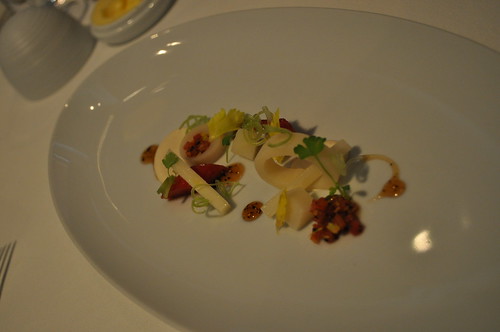
Marcus: For my second course, I went with the salad of Hawaiian hearts of palm with poached rhubarb, celery, Piedmon hazelnuts, and black truffle. I found it to be a zesty, tangy dish, and artistically pleasing to look at, but a bit on the weaker side. Even though I enjoyed the taste, it didn't deliver the punch that the previous dishes were able to provide. I would have much rather gone with the "foie gras en terrine" course that Stefie had ordered (I tried a bite of the brioche with the foie gras and some salt and thought it was multiple orders of magnitude better).
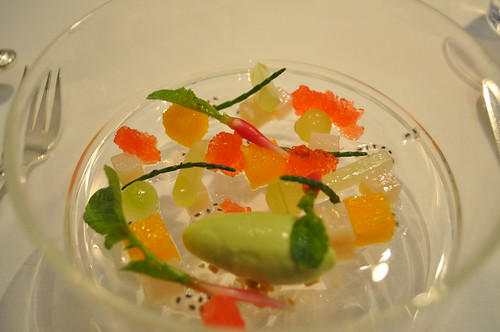
Stefie: For my third course, I selected the tartare of earshell clam with garden radish, cucumber, young coconut, sea beans, navel orange, basil seeds, and avocado "sorbet"--all served in a clear bowl-like serviceware, making the bold colors of all the ingredients pop out. The tartare that I was expecting to appear in front of me was one of a cohesive unit, i.e., earshell clam with the assorted mixture of ingredients meshed together somehow atop of it. Consequently, I was a tad skeptical about the course overall, questioning whether it was all over the place without much focus. I was instantly proven wrong when I took my first scoop of one of the earshell clam cubes with a dab of avocado sorbet, a garden radish, a slice of cucumber, young coconut, a sea bean, some basil seeds, and a cube of navel orange. It was an incredible salad of earshell clam tartare with quality in-season ingredients scattered meticulously throughout. What made it even more interesting was that there was no actual avocado in this dish--just its essence thoroughly captured in the avocado sorbet. The garden of fruits and vegetables highlighted the soft, crunchy (odd-sounding combination unless you've experienced it first hand) texture and taste, typically seen in these bivalves.
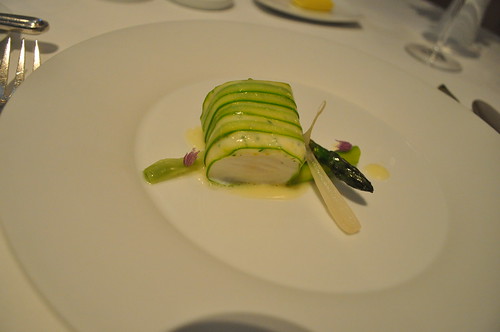
Marcus: Next, I chose the Flétan et St. Jacques en vapeur (a supplemental course) with Meyer lemon, spring onions, green asparagus, chive blossoms, and wild ramps. This was a steamed halibut and was one of the more memorable dishes for me, mainly because it didn't activate my standard response to asparagus and send me fleeing in terror. Instead of being exorbitantly bitter, the asparagus was fairly smoky, sweet, and juicy. I didn't know it was possible for asparagus to be that good. I was also eager to see how the halibut would taste, since I was accustomed to halibut being fine on a textural level, but typically devoid of flavor. In this case, the halibut's flavor was light and yet still firm in its presence. All in all, a very dainty and delicious dish with more flavor than you'd expect from a halibut. I also quite liked the way the halibut was wrapped and how thinly-sliced the encasing greens were -- made for a really interesting technique that added a lot of great texture.

Marcus: From the second round of bread service, I chose both the wheat sourdough (left) and the baguette (right). I was initially asked to choose just one of four breads, but my indecision was obvious and so I was allowed to pick as many as I wanted. I would normally end such a sentence with an unnecessarily obnoxious jackhammering of exclamation points, but I must choose my battles wisely when it comes to revealing my childlike joy.
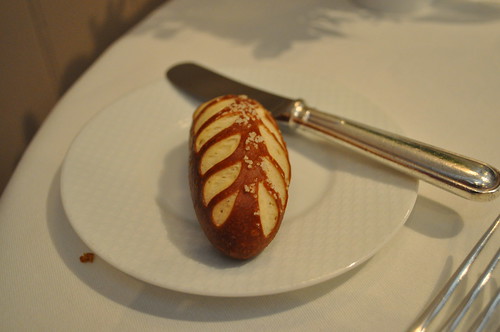
Stefie: I selected the pretzel bread from the second round of bread service. This brought back memories of the pretzels from county fairs and street vendors, with its rich, doughy interior enveloped by the soft crustiness of its freshly baked exterior, of course topped with large granules of "classic pretzel" salt (i.e., white, soft compressed salt).

Stefie: For our fourth course, we were both served sweet butter-poached Maine lobster "Caesar" with sweet garlic "pain perdu," Jidon hen egg emulsion, tomato and Parmesan vinaigrette, and "bottarga di muggine" (i.e., cured roe of red mullet fish) freshly grated and sprinkled over the entire course. Here is another example of Chef Keller's playfulness in his dishes. He calls this lobster "Caesar" in that the ingredients used are inspired by that which are found in Caesar salad (e.g., greens, Parmesan, anchovies, croutons, etc.). Pain perdu is used in many French-speaking countries to denote what we Americans refer to as "French toast." Pain perdu is French for "lost bread," a cleverly fitting name, as "French toast" is a way to reclaim stale or "lost" bread -- hard bread is softened by dipping in a mixture of milk and eggs, and then fried to an eggy delight. In this particular dish prepared at The French Laundry, the sweet butter-poached lobster sits on top of the sweet garlic pain perdu (the "croutons" of this "Caesar" salad) with greens (the "salad"). The tomato and Parmesan "vinaigrette" acted as an unconventional "Caesar" dressing in the form of bits-and-pearls. My only complaint here were the Parmesan pearls were a bit too potent to my liking, but then again, Caesar salad isn't my top choice when it comes to salads. Nevertheless, all of these components came together nicely with the lobster slowly poached to its ideal taste and natural butteriness. The sweet garlic of the soft pain perdu permeated throughout the course's entirety as well. Overall, I found the lobster to be a great segue into the heavier protein courses that remained.
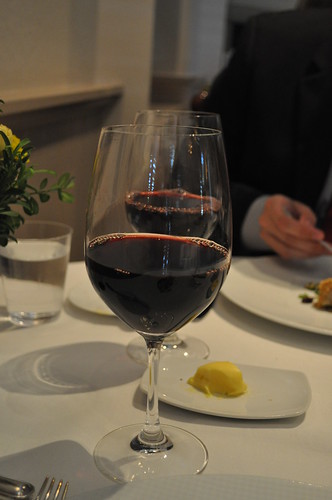
Stefie: In The French Laundry fashion, we were poured our selection of red wine immediately prior to the start of the tasting menu's "meat" courses. We went with the 2001 Bordeaux by Château Beau-Séjour Bécot from Saint Émilion, France. The Bordeaux blend is composed of Merlot, Cabernet Franc, and Petit Bordeaux. When I saw this wine on the "By the Glass" list, it reminded me of the glass of Bordeaux (from Saint Émilion also) that Marcus and I had at Burger & Barrel last year to pair with the infamous white truffle burger -- only difference was that it had a 2000 vintage. It was probably one of the best wines I've tasted and had since I started becoming more interested in wine -- you could definitely notice the 10-year vintage (at the time) had developed a very complex flavor and depth. I was hoping for a similar experience with the similar Bordeaux at The French Laundry, especially since we had rabbit/lamb/beef awaiting us. The 2001 Bordeaux did not disappoint either. It had an oaky smoothness with hints of dark red fruits throughout and was only mildly tannic with a long finish.
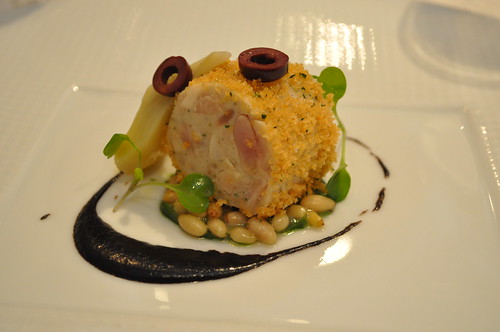
Stefie: Following the lobster was the "boudin de lapin" (i.e., French for "sausage of rabbit") with sunchoke "miette" (i.e., "crumbs" of a particular species of sunflower), globe artichokes, pine nuts, arugula, niçoise olive purée, and "salsa verde." This course is another one with Chef Keller's wit at work--the dish did not have what you would traditionally consider, from its appearance, as sausage made from rabbit. Instead, it is rabbit meat emulated as a cross-section of a thick piece of sausage. If I am totally honest, I really, really didn't like this dish. It was my first time venturing in rabbit territory -- I had never had it before this lunch. I think my disliking of it can be attributed to my realizing that I just don't like rabbit meat. But even for rabbit (and the way I felt about it after trying it), the preparation couldn't have been any better -- the sunchoke "miette" was a refreshing (i.e., more robust in texture and flavor) alternative to the commonplace bread crumbs on cutlets of assorted protein (chicken, veal, pork, etc.) as well as the light nature of panko. The pine nuts were roasted for that awesome crunch effect (as well as to bring out its finest, polished flavor) while the other ingredients complemented it all subtly. In my mind, I knew if there was going to be any kind of rabbit prepared for me to eat ever, Chef Keller was going to be one of the only individuals to prepare it to its maximum potential, showcasing all of the "nooks and crannies" of the meat and its inherent texture/taste, even if it was still ultimately unfavorable (as experienced here) to me. For me, the buck stops here in the realm of being served rabbit as a main course. Perhaps I would have enjoyed it more if it was a protein that I was more familiar with and in tune with its natural flavors -- it had an overwhelmingly gamy taste that I couldn't get past. Nevertheless, I still appreciated the thought, skill, and intellect that went into brainstorming, preparing, and executing the course -- I just wish I could have enjoyed it more. There was never a time that I wanted to like a certain ingredient more than I did here. But alas, rabbit and I weren't meant to be.
Marcus: To interject, I tried a bit of the rabbit and thought it was remarkably flavorful, spicy, and not gamy/stringy at all.
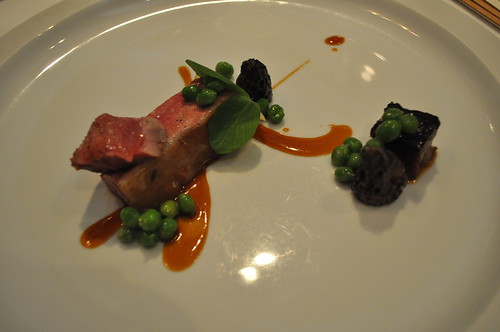
Stefie: My sixth course was the Elysian Fields Farm lamb saddle with "ribettes," morel mushrooms, Yukon gold potato, English peas, Tokyo turnips, and "Paloise" reduction. If not prepared well (or even sourced from a quality purveyor), the lamb at hand can very well taste really gamy. But as we were at The French Laundry, the lamb was prepared to the ideal temperature, resulting in the tenderest medium rare I've ever had for lamb. The meat was juicy and had a subtle undertone of gaminess (the favorable kind). This can be attributable to the "saddle" cut of the lamb, from where the most tender and expensive cuts come. The "Paloise" reduction (i.e., a variation of the classic Béarnaise sauce, which substitutes tarragon for mint, the typical herb pairing for lamb) complemented the lamb very well, most likely due to the legacy pairing between the protein (lamb) and the herb (mint). All in all, the lamb saddle was great with accompanying medley of vegetables.

Marcus: After the lobster dish, I selected the 49-day dry-aged Snake River Farms beef (a supplemental course) with King Trumpet mushrooms, baby beets, French Laundry Garden cabbage, horseradish "pudding" and "sauce bordelaise." This was by far my favorite course of the entire meal. The meat was ridiculously tender, perfectly seasoned, and gushing with flavor (and was further amplified by the horseradish). I was sad to see it go.

Stefie: The seventh course was an Andante Dairy "Acapella" consisting of panisse, eggplant, cilantro, sweet peppers, and Serrano ham. The "Acapella" is, in essence, goat's milk "singing without accompaniment" (as in the choral arts) in that it is supplemented neither with cow or sheep's milk -- in fact, since "Acapella" comes entirely from goats, the milk in "Acapella" retains its rich floral flavor. Because goat's milk is quite costly, many cheese makers create mixed milk cheeses (cow/sheep/goat) to charge a more favorable price. The flavor of the goat's milk wasn't compromised, all right -- I was brave to give it a whirl, but it was too pungent and gamy for my liking. I would imagine goat cheese lovers would go gaga over this, especially since the ultimate goat cheese, "Acapella" is used and finessed to its finest flavor and presentation. On the upside for me, the peppers gave the course a sweet touch to its savory nature.
As Marcus and I were dissecting the cheese course, I just happened broach the topic of Chef Keller, reiterating that I was pretty sure we wouldn't have any counters with him over on the West Coast in Yountville as he was just in New York City for the 2011 James Beard Awards as well as for the grand opening of his second Bouchon Bakery in New York City over at Rockefeller Center. So just as we were discussing this unfortunate circumstance, there he was, standing in front of the kitchen entrance sporting a white chef's jacket with his arms crossed overlooking his well-oiled culinary machine. I was speechless, with my jaw dropped into a widely indiscrete piehole. I motioned to Marcus, informing him that Chef Keller was indeed in town, standing right before us. Chef Keller caught us staring with our starstruck eyes and gapingly open mouths, letting out a smirking sigh and shaking his head slightly. So perhaps we embarrassed ourselves a tad, but the surprise totally threw us off. One minute we were talking about how we had just missed him by coming to the West Coast, and then the next minute, he suddenly appeared, standing in plain view. The next few minutes were barely comprehensible, as I had lost all ability to formulate complete and coherent sentences. Finally gathering myself after the sudden cameo of Chef Keller at The French Laundry, I insisted on asking our captain to see if Chef Keller would be willing to sign our menus. It might have been a long shot, but I figured since we were already here, I didn't have anything to lose. Our captain said he'd be happy to ask, so he'd see what he could do for us.
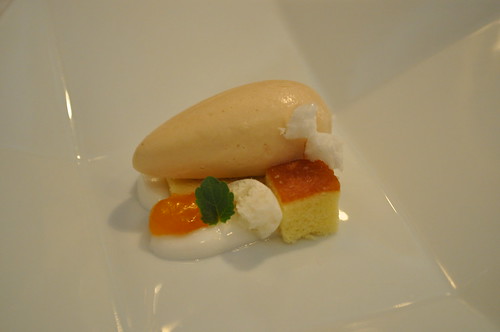
Stefie: The eight course was a palate cleanser featuring Earl Grey sorbet with Royal Blenheim apricot, white honey, and Armando Manni extra virgin olive oil madeleine. I found this palate cleanser -- particularly with its focal ingredient, Earl Grey sorbet -- to be truly refreshing in a very unique way. I had never had a tea-flavored sorbet or palate cleanser, so I thought the creation was a great idea. Instead of committing to a hot pot of freshly brewed tea (with your added choice of honey), it came in a sweeter, more solid form. The madeleine was like the kind of pastries that is served as high tea fare, where the olive oil gave it an interesting savory flavor (as opposed to just sweet). I liked that the course wasn't overpowering -- don't forget, it was a palate cleanser, after all -- which made for a subtle transition into the sweet courses to conclude our lunch.
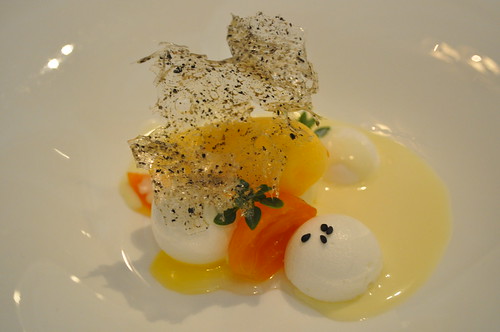
Stefie: For my last course (i.e., dessert), I chose the "île flottante" (French for "floating island" ) with lemongrass, Meiwa kumquat, black sesame, and ginger "anglaise." Île flottante is a classic French dessert that consists of meringue floating on a sea of vanilla custard, also known as crème anglaise, and served with a great drizzle of caramel and topped with some toasted almonds. In Chef Keller's take on this uniquely named dessert, he uses Asian flavors (lemongrass, kumquat, black sesame, and ginger) and incorporates it into the "meringue" (i.e., the "island) as well as the anglaise (i.e., the "sea"). I enjoyed the mix of these ingredients on an otherwise super French dessert -- where it was more tart than savory. The playful approach taken here by The French Laundry kitchen illustrated that creativity need not solely be about the avant-garde or about cutting edge culinary techniques. It could simply just be a clever incorporation of unconventional ingredients in an otherwise traditional composition or a culinary pun (as we've seen in many of the previous courses during this lunch).

Marcus: As dessert, I had the "mousse au chocolat blanc" with morello cherries and marcona almonds. All I can say is that it tasted almost exactly how it looked. Savory, fluffy, and light.

Stefie: Since we had told the mâitre d' that we were celebrating our anniversary via OpenTable, the kitchen prepared us a little treat for our little celebration. It was a miniature ginger cake covered in dark chocolate -- lightly savory and dainty in size.
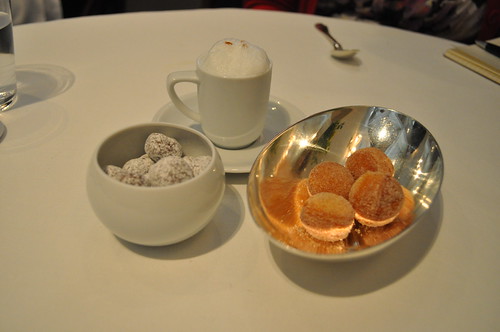
Stefie: As part of the mignardises (i.e., tiny, bite-sized desserts typically served at the end of a meal), we were served one of Chef Keller's signature (and of course, playful) dishes: "coffee and donuts"--a cappuccino semifreddo (i.e., frozen mousse) with miniature brioche thoroughly seasoned with cinnamon sugar (right) and chocolate-covered macadamia nuts (left). This was our last encounter of Chef Keller's humorous take on classic dishes. When you hear that you'll be served "coffee and donuts," you'll most likely expect some fresh donuts served alongside a cup of coffee. Instead, the "coffee" served had the illusion of a cappuccino in an espresso cup, but was actually a coffee-flavored frozen mousse. This mignardise brought back memories of those early mornings that I would have coffee (when I was still a coffee drinker) with a donut or two, only here, Chef Keller made a similar experience in a more refined and sophisticated fashion. Additionally, the macadamia nuts were gently coated with dark chocolate, adding a little bittersweet to its already salty, and had a delicate texture. I wish we had taken these home -- they were so delectable that I had a hard time keeping my hands away from them!
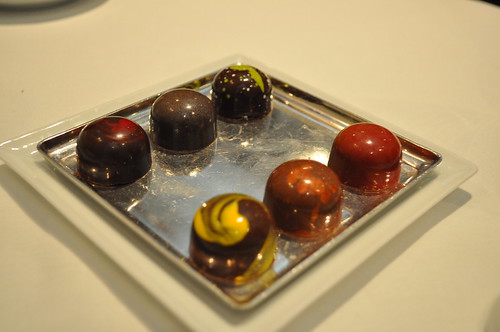
Stefie: These chocolate truffles were also part of the mignardises, coming in assorted flavors. In the back row, from left to right: bing cherry, ginger rum, and olive oil. In the front row, from left to right: lemon, hazelnut, and peanut butter and jelly. My favorites were the olive oil and the hazelnut (when does hazelnut ever NOT go well with chocolate?), while Marcus's favorites were the hazelnut, lemon, and peanut butter and jelly. They were just as amazing in taste as they were in presentation -- each was stained with the colors that would be most associated with the chocolate truffle's designated flavor.
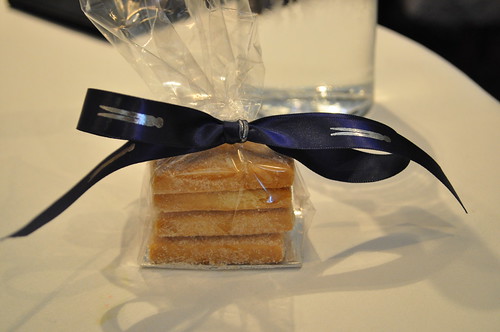
Stefie: As a parting gift, we were given these beautifully wrapped shortbread cookies. I love the ribbon they used -- tied perfectly with the clothespins in the fabric showing! We enjoyed these as a quick snack a couple days later!
Earlier, when we had asked our captain to see if Chef Keller would be kind enough to sign our menus, he returned a few minutes later. "Chef Keller said he won't be able to sign your menus," he paused. As my heart became suspended in letdown mode, he added, "That is, unless he knows who he's signing them for! So your names, please."
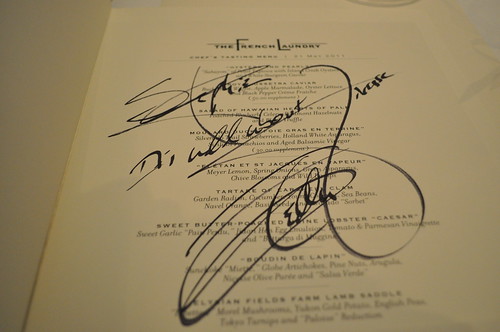
So low and behold -- our menus, signed by Chef Keller himself, with his signature message for The French Laundry: "It's all about finesse!"

Here's Marcus's signed menu, too.
Findings:
Stefie: Perhaps what I had been initially expecting, deep down, was a transformative emotion to overtake and overwhelm me with a sensation of my mind being blown (like I had during my visit to Chef Grant Achatz's Alinea). Sure, the nine-courses, particularly ingredients and preparations, were as perfect as you'd expect them to be -- execution was not compromised one bit. But here was the problem -- I didn't exhibit the reaction (a la Alinea) I imagined myself having at The French Laundry. I'm not going to lie -- I was a bit disappointed with this. I expected more from the restaurant and the masters in its kitchen.
However, I would have to say that our experience at The French Laundry certainly met the restaurant's mission of ensuring its patrons "feel welcomed, relaxed, and at ease, and most of all happy" with no intention of trying to impress. In fact, this humble mindset is what is most impressive at all, without trying to be. Understanding this specific goal after our visit helped me better appreciate the meal I had been waiting for most of my life to have, instead of being torn with the initial disconnect and minor disappointment. Learning more about The French Laundry, its culture, and its intentions, as curated by Chef Keller and carried out by his amazing kitchen and service staff, also helped me further understand The French Laundry on a whole other level, putting my unfavorable reaction to rest. Just when I lost my faith in the restaurant that I had held to the highest standard and pedestal of respect, The French Laundry had won me over once again.

The atmosphere of the restaurant had a certain calmness to it, filled with lovely energetic chatter where you could still clearly hear and have an audible conversation with the guests at your table. Just as we found with the restaurant's peaceful, unassuming exterior, there was no pretension or stuffiness to it -- The French Laundry today is just as humble as its beginnings. The chef's tasting menu had been a smooth progression of coherent and deliberate courses crafted with well-honed techniques in Chef Keller's kitchen. If you didn't take a thorough look through the tasting menus before the courses were served, chances were that you probably missed the playful, tongue-in-cheek approach that Chef Keller takes with many of the courses on each day's menu (most of these are denoted in cleverly placed quotation marks in a given menu item's description). I certainly did the first time around! When Marcus and I were working on compiling this blog review post together, we discovered many of these "inside jokes" and humor that only the well-informed culinarians and well-read food enthusiasts would understand. It's one thing to know how to execute complex cooking techniques (especially in the discipline of French cuisine) consistently and accurately, but it is an entirely different kind of talent (one that is unique and exceptional) when a chef can show off his culinary intellect with a simple thing as a pun on a dish name by playing with the ingredients. You see this best with the "Oysters and Pearls" as well as with the "cornets" of salmon tartare among others. Sure, there will be patrons sitting in the dining rooms of The French Laundry that are there only for the exclusivity and high demand that its reservations sustain, but when there are those who actually appreciate the art of cooking, gastronomy, and the like, not just because of the famed titles and stars it has earned, the experience transcends all that is on the surface. In this respect, you've gained a thorough understanding and a deeper appreciation for the establishment that Chef Keller and his staff have built and continue to build. It is a place where French-American cuisine is revered and showcased in a nearly flawless manner. No big surprises or crazy plating. Just really, really well-prepared food that is artistically and intellectually crafted for your sole, relaxed enjoyment. With all of this at hand, the attention to detail at The French Laundry is unparalleled, in all aspects -- menu composition (with no ingredients repeated), service, and décor. Examples of this detail was demonstrated with the wide spectrum of salts offered alongside the foie gras en terrine, the service team knowing when you need them, and the clothespin used as a napkin holder.
I finally understood what a meal at The French Laundry was ultimately about -- being comfortable. The service team was wonderful -- knowledgeable when called upon, resourceful when ou least expect it (i.e., knowing what you need before you know you need it), and pleasant (but not overwhelmingly in your face). It is the kind of service most, if not all, restaurants strive to be like. There are only a couple places for which I can say service is their strongest suit -- this seemingly simple attribute is less common than you may think. The French Laundry really hits the nail in this regard with no question. This is what fine dining should be -- a strong, consistently pleasing menu alongside impeccable service that is both humble and welcoming.
So after all those years of dreaming what my eventual meal at The French Laundry would be like, it was comforting to know that I left with a smile on my face with my other half (in the spirit of corny puns, of course) along my side, both of us with the happiest stomachs we could have after an amazingly orchestrated nine-course tasting menu. The added surprise of having our menus signed by Chef Keller himself made the lunch that much more special. I look forward to a visit to the restaurant's East Coast sister, Per Se. When that time comes, it'll be interesting to compare the menu offerings, culture (similar to The French Laundry, I'd bet), and everything else. I would also be interested in trying the tasting of vegetables. After experiencing a vegetarian lunch that didn't feel "stereotypically vegetarian" at Ubuntu, I'm now very curious to see if other highly esteemed dining establishments would be able to bring the same energy and robust flavors as well as variety of "alternative ingredients" -- knowing The French Laundry's high quality of ingredients (from its own farm across the road, no less) as well as its vault of talented chefs working in its kitchen, it wouldn't disappoint.
All in all, lunch at The French Laundry was not just a lunch that I will never forget, but an experience that will stay with me always. As such, I'll never look at The French Laundry Cookbook the same way ever again, as I'll be able to look at it now with an enlightened palate and more knowledge in context.
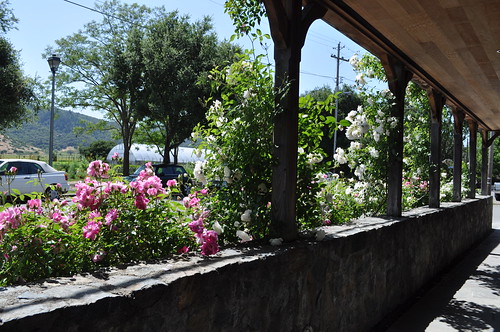
Marcus: I can definitely say that the ingredients used at The French Laundry were top-notch and would be easy to identify, even standalone. The sheer (and consistent) strength of the flavors is no shock when you consider that many of the ingredients are grown at a farm literally right next to the restaurant. Each course is very artistic and presented with an elegant grace, allowing me to indulge in what the Japanese call "eating with the eyes." The attention to detail couldn't be more obvious or ubiquitous, ranging from not only the myriad techniques employed in the food, but right down to little things like the laundry-ticket the bill is printed on. In terms of service, I'm not sure how it could be improved upon. My water glass was never empty for more than a matter of seconds, which is an inhuman feat for any waiter because I drink water like a parched desert horse. Plates were removed and replaced immediately, and the staff was knowledgeable, kind, and accommodating. The fact that Chef Keller himself was present and willing to sign our menus was a hugely pleasant surprise.
Walking out of the restaurant, I reflected a bit on my earlier thoughts and questions. Chef Keller outright claims that trying to impress guests isn't the point. It's about providing a luxurious experience with good food for the sake of happiness, where "luxury" is defined by Chef Keller as "having someone make decisions for you, to eliminate the stress of decision making." The next logical question is, therefore, "Do the decisions actually make you happy?" The answer, I think, is "yes." The menu has just enough choice to give you control over some major components of the meal's progression, and yet not so much choice that you're paralyzed or left unsatisfied as a result of opportunity cost (although I do wish that I chose the foie gras dish over my salad). There's also a sort of shotgun effect present; a wide variety of different breads are repeatedly placed on your table at different points throughout the meal, followed by a barrage of desserts at the very end that aren't even on the menu. The sensation of luxury is decadent (and I categorically hate using that word) due to the fact that, in the end, you will have sampled a large array of foods with no repeating ingredients, where those ingredients are the ne plus ultra of quality -- and all without any effort required on your behalf whatsoever. A sort of guilty indulgence permeates the meal that, at first, embarrassed me, but it was a lot like being the first kid to start dancing at the middle school prom. At some point you need to let loose and just enjoy yourself.
I think The French Laundry has to be assessed with a bit of context to really get the most out of it. If you're trying to get a reservation simply because it's hard to get a table and because you expect to have your quintessential foundations of taste utterly shattered and tossed to the wind, I think you'll be doing yourself a disservice. There's an intellectual component to the meal -- a lot of technique and humor strung throughout the menu, and it can be easy to miss if you are too fixated on the usual suspects of taste and service. In some ways I almost felt frustrated at my own ignorance, because it was too easy for me to gloss over the jokes, as my knowledge of French cuisine was not fully-fleshed. Luckily, certain dishes like the "sausage of rabbit" were a bit easier to understand -- it was clearly not "rabbit sausage" but a cross-section of rabbit encased in a sort of breading, analogous to how sausage might be prepared by encasing ground meat with a thin veneer of intestine. Other famous dishes by Chef Keller include "Lobster Navarin," Salmon "Chops," and "Mac and Cheese," which are interesting because "navarin" is associated with lamb shoulder, fish don't really have "chops," and the macaroni and cheese is actually a sort of lobster pasta with mascarpone cheese sauce. In hindsight, the salmon "cornet" was an excellent prelude to the rest of the meal in terms of what to expect from Chef Keller.
But will you like the food? The author Malcolm Gladwell might argue "possibly not" -- as there is, for an example, no "good" or "bad" coffee -- just different types of coffee for different types of people. There's no such thing as a perfect meal, and this is a view Chef Keller shares. It's all in the eye of the beholder. While I loved the rabbit dish, Stefie was not a fan of it because she simply dislikes the taste/texture of rabbit. That doesn't make it a bad dish. If you have an affinity for rabbit, you'll probably appreciate the way it is prepared at The French Laundry. I love beef and fell head over heels for the 49-day dry-aged Snake River Farms beef course, but I wasn't a fan of the salad of Hawaiian hearts of palm. In other words, with such a multifaceted meal, you're bound to have a few hits and possibly a few misses. Regardless, nothing was undercooked, overcooked, improperly seasoned, or imbalanced.
Does The French Laundry live up to the hype? In my opinion, the hype is a combination of both truth and myth. Too many people go in thinking it's supposed to be a transformative pinnacle of perfection, because for countless others, it is. I think there's this widespread expectation for The French Laundry to accomplish what is akin to creating a new, previously-unfathomable color on the electromagnetic spectrum. If this is what you walk in looking for, you probably won't find it. I admit that I was somewhat guilty of this going in despite my best efforts to calibrate my expectations to a state of pure balance, tabula rasa style. I left the restaurant happy, yet disappointed that my initial assessment was not too far off from the truth. I wanted my expectations to be exceeded, but when you expect a fantastically marvelous meal and get a fantastically marvelous meal, your expectations are simply met. As always, the key to life is low expectations! My advice: Tell your friends that The French Laundry is "just some rinky-dink French joint with a dress code" and enjoy the inexorable fireworks when you finally bring them. The hype exists because the food is incredible. Chef Keller enjoys tinkering around with memories, and so a lot of the flavors you'll experience aren't anything you haven't experienced before in some capacity, but that's not to say you won't love what you find.
Finally, I'll address the nagging question I am sure is on everyone's mind: Is The French Laundry worth the price? It's not easy to blast through a grand on a single meal. Many people who do decide to go through with the expenditure expect to have the meal of the century -- they want their minds to be blown into a comatose state of euphoria held together only by the wine tannins flowing through their bloodstreams. In terms of price, if all you're after is a really good meal at a decent value, you don't need to spend a lot. We go to restaurants to eat -- so what's all this talk of "experience"? Is it not reasonable to expect that the price you pay go into the food and not the tablecloth? Arguably it is, but with the high price, you get superlative ingredients handled with inspired, creative techniques, and lots of talent -- not to mention the rustic, charming setting in Yountville, the extensive wine list, and the astounding service. I'll put it this way: You probably haven't had too many meals better than this. A great number of restaurants, in my opinion, charge a killing for their food for the sake of trying to establish a sort of Veblen-good brand name or to provide atmosphere that makes up for an otherwise subpar menu. The French Laundry does not fall into this category. It costs a lot to dine there, but you get a lot in return. If the added bells and whistles aren't really in line with your preferences and what you consider to be essential components of a top dining experience, then perhaps you are better off looking elsewhere for great American/French cuisine.
Price point: $270 per person for nine-course chef's tasting menu with service included, $50 supplement for Royal Ossetra as first course, $30 supplement for foie gras en terrine as second course, $75 supplement for 49-day dry-aged beef as sixth course, $16 for each glass of Riesling, $36 for each glass of Bordeaux.
--May 21, 2011
The French Laundry
6640 Washington Street
Yountville, CA 94599
http://www.frenchlaundry.com

No comments:
Post a Comment